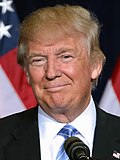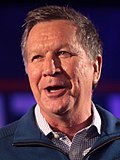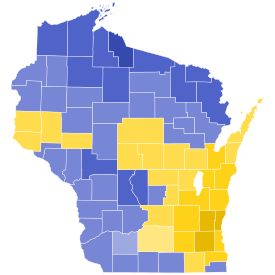2016 Wisconsin Republican presidential primary
| |||||||||||||||||||||||||
| |||||||||||||||||||||||||
| |||||||||||||||||||||||||
| Elections in Wisconsin |
|---|
 |
The 2016 Wisconsin Republican presidential primary was held on April 5 in the U.S. state of Wisconsin as one of the Republican Party's primaries ahead of the 2016 presidential election. Texas senator Ted Cruz won the contest with 48%, ahead of nationwide frontrunner Donald Trump by 13 percentage points. Taking advantage of the state's two-level "winner takes all" provision, Cruz took 36 out of the 42 available delegates.
The Wisconsin Democratic primary, held on the same day in conjunction with the Republican primary, yielded a win for Bernie Sanders, who defeated nationwide frontrunner Hillary Clinton by 13 percentage points. With no other primaries being scheduled for that day by either party and just two weeks ahead of the important New York primary, the Wisconsin primary was in the national spotlight.
The two parties' primaries were held in conjunction with this year's Wisconsin judicial elections, where Wisconsin Supreme Court justice Rebecca Bradley was confirmed for a 10-year elected term, winning over Appeals Court judge JoAnne Kloppenburg.[1]
Despite Ted Cruz's win, the eventual nominee, Donald Trump, went on to win the state on Election Day, held on November 8.
Procedure
[edit]State primary procedure
[edit]As Wisconsin held an open primary, residents could choose freely which party's primary they wished to participate in, when showing up at the polls on election day, regardless of their official registration with either party or none. Polling stations were opened between 7 a.m. and 8 p.m. Central Time.[2]
The two parties' primaries were held in conjunction with this year's Wisconsin judicial elections that included the election of the Wisconsin Supreme Court justice.[1]
Republican nomination procedure
[edit]The Republican Party of Wisconsin pledges all of its 42 delegates to the 2016 Republican National Convention based on the popular vote at the primary election on the basis of a "Winner takes all" provision. However, only the 18 at-large delegates are awarded to the statewide plurality winner, while the 24 district delegates, three for each of the state's eight congressional districts, are given to the district-wide winner.[3]
Candidates
[edit]While twelve candidates appeared on the Republican primary ballot,[4] only three of the candidates actively campaigned for the Wisconsin contest, after all other candidates had already suspended their campaigns.
Presidential debate in Milwaukee, November 2015
[edit]The Republican Party held its fourth presidential debate on November 10, 2015 in Milwaukee, at the Milwaukee Theatre. Moderated by Neil Cavuto, Maria Bartiromo and Gerard Baker, the debate aired on the Fox Business Network and was sponsored by The Wall Street Journal. Eight candidates including Donald Trump, Ben Carson, Marco Rubio, Ted Cruz, Jeb Bush, Carly Fiorina, John Kasich, and Rand Paul, participated in the primetime debate that was mostly focused on jobs, taxes, and the general health of the U.S. economy, as well as on domestic and international policy issues. The accompanying undercard debate featured Chris Christie, Mike Huckabee, Rick Santorum, and Bobby Jindal who ended his campaign a week after the debate.
Campaigns
[edit]Social conservative Texas senator Ted Cruz, who enjoyed the endorsement of the united Republican Party establishment, including Wisconsin Governor Scott Walker, was expected to come out in front.[5] Most polls saw him leading the current national frontrunner, populist New York businessman Donald Trump narrowly by single-digits. Trump maintained he would prevail in spite of the Republican establishment endorsing Cruz, and was "going to have a really, really big victory".[6] With the Never Trump camp closing ranks around an expected Cruz victory in Wisconsin, the third candidate, fiscal conservative Ohio governor John Kasich, was not expected to be competitive in the more populous areas of Wisconsin, and shifted his focus on the more rural congressional districts in order to win at least some of the per-district delegates.[7] Just a few days ahead of the primary, Trump openly asked Kasich to drop out of the race.[8] Kasich was also heavily attacked in TV commercial by both frontrunners' SuperPACs.[9]
Opinion polling
[edit]| Poll source | Date | 1st | 2nd | 3rd | Other |
|---|---|---|---|---|---|
| Primary results[10][self-published source] | April 5, 2016 | Ted Cruz 48.20% |
Donald Trump 35.02% |
John Kasich 14.10% |
Marco Rubio 0.96%, Ben Carson 0.51%, Jeb Bush 0.28%, Rand Paul 0.23%, Mike Huckabee 0.13%, Chris Christie 0.11%, Carly Fiorina 0.07%, Rick Santorum 0.05%, Jim Gilmore 0.02% |
| ARG[11]
Margin of error: ± 5% Sample size: 400 |
April 1–3, 2016 | Donald Trump 42% |
Ted Cruz 32% |
John Kasich 23% | Undecided 3% |
| Emerson College[12]
Margin of error: ± 4.1% Sample size: 549 |
March 30 - April 3, 2016 | Ted Cruz 40% |
Donald Trump 35% |
John Kasich 21% |
Undecided 4% |
| CBS News/YouGov[13]
Margin of error: ± 5.7% Sample size: 675 |
March 29-April 1, 2016 | Ted Cruz 43% |
Donald Trump 37% |
John Kasich 18% |
Other/Don't Know 2% |
| Fox Business News[14]
Margin of error: ± 3.5% Sample size: 742 |
March 28–30, 2016 | Ted Cruz 42% |
Donald Trump 32% |
John Kasich 19% |
Other 1%, Don't Know 5% |
| Loras College[15]
Margin of error: ± 4.8% Sample size: 416 |
March 28–30, 2016 | Ted Cruz 38% |
Donald Trump 31% |
John Kasich 18% |
Undecided 13% |
| Public Policy Polling[16]
Margin of error: ± 3.5% Sample size: 768 |
March 28–29, 2016 | Ted Cruz 38% |
Donald Trump 37% |
John Kasich 17% |
Undecided 9% |
| Marquette University[17]
Margin of error: ± 5.8% Sample size: 471 |
March 24–28, 2016 | Ted Cruz 39.6% |
Donald Trump 30.4% |
John Kasich 21.4% |
Someone Else 0.3%, Undecided 7.7% |
| Optimus[18]
Margin of error: ± 1.1% Sample size: 6182 |
March 20–24, 2016 | Donald Trump 29.4% |
John Kasich 27.1% |
Ted Cruz 25% |
Undecided 18.6% |
| Emerson College[19]
Margin of error: ± 4.6% Sample size: 439 |
March 20–22, 2016 | Ted Cruz 36% |
Donald Trump 35% |
John Kasich 19% |
Undecided 10% |
| Marquette University[20]
Margin of error: ± 7.5% Sample size: 297 |
February 18–21, 2016 | Donald Trump 30% |
Marco Rubio 20% |
Ted Cruz 19% |
Ben Carson 8%, John Kasich 8%, Jeb Bush 3%, Undecided 10% |
| Marquette University[21]
Margin of error: ± 6.5% Sample size: 313 |
January 21–24, 2016 | Donald Trump 24% |
Marco Rubio 18% |
Ted Cruz 16% |
Ben Carson 8%, Chris Christie 5%, Rand Paul 3%, Carly Fiorina 3%, Jeb Bush 2%, John Kasich 2%, Mike Huckabee 1%, Rick Santorum 0%, Undecided 17% |
| Marquette University[22]
Margin of error: ± 6.6%
|
November 12–15, 2015 | Ben Carson 22% |
Donald Trump 19% |
Marco Rubio 19% |
Ted Cruz 9%, Jeb Bush 6%, Carly Fiorina 5%, Chris Christie 4%, Rand Paul 1%, Mike Huckabee 1%, John Kasich 1%, George Pataki <0.5%, Jim Gilmore <0.5%, Someone else 0.6%, Undecided 9.8% |
| Marquette University[23]
Margin of error: ± 6.5%
|
September 24–28, 2015 | Donald Trump 20.1% |
Ben Carson 16.2% |
Marco Rubio 14.4% |
Carly Fiorina 10.8%, Jeb Bush 6.6%, Ted Cruz 5.1%, Rand Paul 4.5%, Mike Huckabee 3.4%, Chris Christie 3.1%, John Kasich 2.8%, Rick Santorum 1.2%, Bobby Jindal 0.5%, George Pataki 0.4%, Jim Gilmore 0.2%, Someone else 0.6%, Undecided 9.8% |
| Marquette University[24]
Margin of error: ± 6.6%
|
August 13–16, 2015 | Scott Walker 25% |
Ben Carson 13% |
Donald Trump 9% |
Ted Cruz 8%, Carly Fiorina 7%, Marco Rubio 7%, Jeb Bush 6%, Mike Huckabee 4%, Bobby Jindal 2%, Chris Christie 2%, Rand Paul 2%, Rick Perry 1%, John Kasich 1%, Jim Gilmore 1%, Rick Santorum 1%, George Pataki 0%, Lindsey Graham 0% |
| Marquette University[25]
Margin of error: ± 5.6%
|
April 7–10, 2015 | Scott Walker 40% |
Rand Paul 10.3% |
Jeb Bush 7.9% |
Ted Cruz 6%, Chris Christie 5.8%, Mike Huckabee 5.1%, Ben Carson 5%, Marco Rubio 3.8%, Bobby Jindal 2.3%, Rick Santorum 1.9%, Carly Fiorina 0.5%, Rick Perry 0.5%, Someone else 1.7%, Don't know 8.9% |
| Public Policy Polling[26]
Margin of error: ± 4.6%
|
March 6–8, 2015 | Scott Walker 53% |
Ben Carson 12% |
Jeb Bush 8% |
Rand Paul 6%, Marco Rubio 6%, Chris Christie 4%, Mike Huckabee 3%, Ted Cruz 2%, Rick Perry 1%, Undecided 5% |
| Public Policy Polling[27]
Margin of error: ± 4.3%
|
April 17–20, 2014 | Paul Ryan 25% |
Scott Walker 21% |
Chris Christie 8% |
Mike Huckabee 8%, Rand Paul 8%, Ted Cruz 7%, Jeb Bush 6%, Marco Rubio 6%, Bobby Jindal 3%, Someone else/Not sure 8% |
| Magellan Strategies[28]
Margin of error: ± ?
|
April 14–15, 2014 | Scott Walker 37% |
Rand Paul 12% |
Ted Cruz 9% |
Mike Huckabee 9%, Jeb Bush 8%, Marco Rubio 8%, Chris Christie 4%, John Kasich 1%, Undecided 12% |
| Marquette University Law School[29]
Margin of error: ± 5%
|
October 21–27, 2013 | Scott Walker 28.9% |
Paul Ryan 24.6% |
Marco Rubio 9.3% |
Chris Christie 8.6%, Rand Paul 8.4%, Ted Cruz 4.3%, Jeb Bush 2.4%, Someone else 4.2%, Don't know 8.9% |
| Public Policy Polling[30]
Margin of error: ± 4.6%
|
September 13–16, 2013 | Paul Ryan 27% |
Scott Walker 14% |
Chris Christie 12% |
Marco Rubio 10%, Ted Cruz 9%, Jeb Bush 8%, Rand Paul 8%, Bobby Jindal 3%, Rick Santorum 3%, Someone else/Not sure 5% |
| Paul Ryan 33% |
Chris Christie 14% |
Jeb Bush 11% |
Rand Paul 11%, Ted Cruz 10%, Marco Rubio 9%, Rick Santorum 6%, Bobby Jindal 3%, Someone else/Not sure 5% | ||
| Scott Walker 37% |
Chris Christie 13% |
Jeb Bush 11% |
Ted Cruz 10%, Rand Paul 10%, Marco Rubio 9%, Rick Santorum 4%, Bobby Jindal 2%, Someone else/Not sure 3% | ||
| Paul Ryan 47% |
Scott Walker 38% |
Not sure 15% | |||
| Marquette University Law School[31]
Margin of error: ± 5.8%
|
May 6–9, 2013 | Paul Ryan 27.1% |
Marco Rubio 21.2% |
Scott Walker 16.1% |
Chris Christie 10.6%, Rand Paul 6.9%, Jeb Bush 4.6%, Bobby Jindal 0.8%, Someone Else 1.6%, Don't Know 10.5% |
| Public Policy Polling[citation needed]
Margin of error: ± 3.8%
|
February 21–24, 2013 | Paul Ryan 35% |
Marco Rubio 22% |
Chris Christie 10% |
Rand Paul 8%, Mike Huckabee 7%, Jeb Bush 5%, Bobby Jindal 3%, Susana Martinez 1%, Rick Perry 1%, Someone Else/Undecided 8% |
| Scott Walker 33% |
Marco Rubio 27% |
Chris Christie 10% |
Mike Huckabee 7%, Rand Paul 6%, Jeb Bush 5%, Bobby Jindal 3%, Susana Martinez 2%, Rick Perry 0%, Someone Else/Undecided 8% |
Results
[edit]With 48.25% of the statewide vote, Texas senator Ted Cruz distanced nationwide frontrunner Donald Trump by some 13%, thereby winning all 18 at-large delegates.[5] Out of the eight congressional districts, Cruz won in six, therefore receiving another 18 district-wide delegates, while Donald Trump took home six district-wide delegates from western Wisconsin, where he won the 3rd and the 7th congressional districts.[3]
| Candidate | Votes | Percentage | Actual delegate count | ||
|---|---|---|---|---|---|
| Bound | Unbound | Total | |||
| Ted Cruz | 533,079 | 48.20% | 36 | 0 | 36 |
| Donald Trump | 387,295 | 35.02% | 6 | 0 | 6 |
| John Kasich | 155,902 | 14.10% | 0 | 0 | 0 |
| Marco Rubio (withdrawn) | 10,591 | 0.96% | 0 | 0 | 0 |
| Ben Carson (withdrawn) | 5,660 | 0.51% | 0 | 0 | 0 |
| Jeb Bush (withdrawn) | 3,054 | 0.28% | 0 | 0 | 0 |
| Rand Paul (withdrawn) | 2,519 | 0.23% | 0 | 0 | 0 |
| Uncommitted | 2,281 | 0.21% | 0 | 0 | 0 |
| Mike Huckabee (withdrawn) | 1,424 | 0.13% | 0 | 0 | 0 |
| Chris Christie (withdrawn) | 1,191 | 0.11% | 0 | 0 | 0 |
| Carly Fiorina (withdrawn) | 772 | 0.07% | 0 | 0 | 0 |
| Rick Santorum (withdrawn) | 511 | 0.05% | 0 | 0 | 0 |
| Jim Gilmore (withdrawn) | 245 | 0.02% | 0 | 0 | 0 |
| Victor Williams (write-in) | 39 | <0.01% | 0 | 0 | 0 |
| Unprojected delegates: | 0 | 0 | 0 | ||
| Total: | 1,105,944 | 100.00% | 42 | 0 | 42 |
| Source: The Green Papers | |||||
Reactions and aftermath
[edit]Cruz's unexpectedly large victory in Wisconsin was widely seen as a turning point for the Donald Trump campaign,[32] making it less likely for Trump to win an outright majority of all national delegates, even if he should win a plurality of delegates. Without an outright majority in the 2016 Republican National Convention's first ballot, the delegates won by Trump would be able to switch to Cruz or another candidate in subsequent ballots, as they were pledged to support him only in the first ballot. Given the Republican establishment's pressure not to nominate Trump, many commentators expected Cruz to be better positioned in subsequent ballots.[33] The theory of Trump's demise proved to be false. As the primary schedule moved to the Northeast, including his home state of New York, Trump increased his margin of victory and won almost all of the delegates. Finally, with his victory in the Indiana primary, Trump became the presumptive nominee.
References
[edit]- ^ a b Patrick Marley (April 6, 2016). "Rebecca Bradley beats JoAnne Kloppenburg in high court race". Milwaukee Journal Sentinel. Retrieved April 6, 2016.
- ^ Michele Gorman (April 5, 2016). "How to follow voting results in Wisconsin". Newsweek. Retrieved April 6, 2016.
- ^ a b "Wisconsin Republican primary, 2016". The Green Papers. Retrieved April 6, 2016.
- ^ "Candidates on ballot: 2016 spring election and presidential preference vote" (PDF). Wisconsin Government Accountability Board. March 29, 2016. Archived from the original (PDF) on April 15, 2016. Retrieved April 6, 2016.
- ^ a b John Cassidy (April 6, 2016). "Big Wins for Bernie Sanders and Ted Cruz Set up Two Showdowns in New York". The New Yorker. Retrieved April 6, 2016.
- ^ Adam Edelman (April 5, 2016). "Polls show Cruz, Sanders ahead in Wisconsin before Tuesday primaries". New York Daily News. Retrieved April 6, 2016.
- ^ David Weigel (March 29, 2016). "Kasich plays for Wisconsin delegates, not statewide win". Retrieved April 6, 2016.
- ^ Allie Malloy; Sara Murray (April 4, 2016). "Trump: Kasich shouldn't be allowed to run". CNN. Retrieved April 6, 2016.
- ^ Chrissie Thompson (April 5, 2016). "John Kasich fights back as Ted Cruz, Donald Trump pile on in Wisconsin primary". The Cincinnati Enquirer. Retrieved April 6, 2016.
- ^ Primary results
- ^ "2016 Wisconsin Republican Presidential Primary". American Research Group. Archived from the original on April 6, 2016. Retrieved April 4, 2016.
- ^ "EMERSON POLL: Wisconsin Feels the Bern While Cruz has Momentum Going into Primaries" (PDF). Emerson College Polling Society. Retrieved April 5, 2016.
- ^ "Close races in Wisconsin; Clinton and Trump ahead in New York". YouGov. Retrieved April 4, 2016.
- ^ "FOX Business Network Poll: Cruz Leads in Wisconsin". Anderson Robbins Research and Shaw & Company Research. March 31, 2016. Retrieved April 1, 2016.
- ^ "Loras College Poll finds Cruz tops Trump, Clinton leads Sanders, tight race for state supreme court in Wisconsin". Loras College. Archived from the original on April 5, 2016. Retrieved April 3, 2016.
- ^ "Subject: Sanders leads in Wisconsin; GOP Race Close; VA Privatization Issue Hurts Johnson" (PDF). Public Policy Polling. Retrieved April 1, 2016.
- ^ "Marquette Law School Poll – March 24-28, 2016" (PDF). Marquette Law School. Retrieved March 31, 2016.
- ^ "Wisconsin Republican Presidential Primary". Optimus. Retrieved March 30, 2016.
- ^ "EMERSON POLL: WISCONSIN PRIMARY INPLAY FOR BOTH PARTIES; CRUZ LEADS TRUMP BY A POINT; CLINTON UP 6 OVER SANDERS; CRUZ FARES BETTER THAN TRUMP IN GENERAL AGAINST CLINTON" (PDF). Emerson Polling Society. Retrieved March 24, 2016.
- ^ "New Marquette Law School Poll finds tight Democratic race, Trump maintaining Republican lead in Wisconsin". Marquette University. June 20, 2012. Retrieved February 26, 2016.
- ^ "New Marquette Law School Poll finds tight races in Wisconsin presidential primaries". Marquette University. January 25, 2012. Retrieved January 30, 2016.
- ^ Marquette University
- ^ Marquette University
- ^ Marquette University
- ^ Franklin, Charles (April 16, 2015). "Marquette Law School Poll finds Walker job approval down". Marquette University.
- ^ Public Policy Polling
- ^ Public Policy Polling
- ^ Magellan Strategies
- ^ Marquette University Law School
- ^ Public Policy Polling
- ^ Marquette University Law School
- ^ James Hohmann (April 6, 2016). "The Daily 202: Trump's double-digit loss in Wisconsin is a big deal. What comes next?". The Washington Post. Retrieved April 6, 2016.
- ^ Avik Roy (April 6, 2016). "Ted Cruz's Wisconsin Win May Be The Beginning Of The End For Donald Trump". Forbes. Retrieved April 6, 2016.





